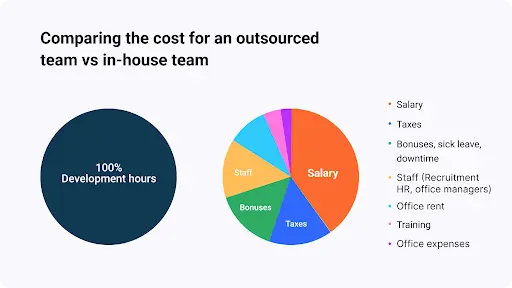- Product development
- 16 Oct 2024
Average cost of mobile app development
What B2B tech companies need to know.

Table of contents
- Breaking down mobile application development costs: What B2B tech companies need to know.
- Mobile app development costs got you overwhelmed?
- Feeling the pressure of rising mobile app development costs? It’s hitting your budget harder than you think
- Cost of hiring mobile app developers
- In-house vs. outsourcing: The smartest way to develop your mobile app on a budget
- The takeaway: Choosing the best mobile app development option for your needs
Contributors
Breaking down mobile application development costs: What B2B tech companies need to know.
As a founder or product manager, you may be wondering about the cost of developing a mobile app for your business. Several factors influence the total cost, including app complexity, features, design, platform, and development team.
In this article, we will break down these key factors to provide you with a clearer understanding and a rough estimate of the investment required to build a mobile app tailored to your business needs.
Mobile app development costs got you overwhelmed?
- Factors influencing mobile app cost
App Complexity
First, consider the app’s complexity. If you choose a simpler app, you can save a significant amount of time and money on mobile app costs. Sure, adding flashy features can make your app pop, but that extra spice can also stretch your budget and timeline. Ask yourself:
- What features do I really want to add to my app?
- Is my concept easy for my audience to grasp?
- How many screens, buttons, and functions will my app have?
App Type
Next, let’s talk about the app type. If you’re going the native route, you’ll be working with programming languages that are specific to each device’s operating system. For Android, think Java or Kotlin; for iOS, you’re looking at Objective C or Swift.
Features
Now, let’s get into the nitty-gritty of features that can massively influence mobile application development cost. Functionality really matters here. If you want to pack in a lot of extra features, be prepared for longer development cycles since they’re released one at a time. A basic file upload will cost you less compared to more complex features like augmented reality or social feed algorithms.
Supported Platforms
You also need to consider which platforms you’ll support. Whether you choose Android or iOS, the app dev cost for both is pretty similar at the start. If you want your app on both platforms, know that it’s more time-consuming and costly since developers have to work in different programming languages for each.
Going with a cross-platform framework like React Native could be a smart move for your budget. It allows developers to write the code once and deploy it across multiple platforms, cutting down your mobile application development cost significantly.
Location
Another big player in your mobile app cost is the location of your developers. If you’re hiring in the U.S., expect to pay a premium. But if you look at places like Eastern Europe, you might find more affordable rates. Just remember, cultural differences can slow down communication, which could impact your timeline.
If you’re considering outsourcing, check why Romanian software outsourcing is a great option. The developers are skilled, the pricing is competitive, and their work style aligns well with Western practices, making it a smart choice for cost-effective mobile app development.
App Design Complexity
Don’t overlook app design complexity either. It’s crucial for user engagement but can also impact your app development budget. You’ll have to choose between custom or standard UI. Custom designs tend to be more expensive because they require extra effort to create.
User experience matters, too—where you place buttons, color choices, and overall layout can all influence your mobile app development costs. And if you want your app to stand out, you’ll need to invest extra in branding design.
Type of Collaboration
Finally, consider how you want to collaborate. If you’re after complete customization, you’ll need a developer on board. Your options include:
- Building an internal team.
- Hiring freelancers.
- Partnering with an outsourcing firm.
Each approach has its pros and cons, especially in terms of cost. Hiring freelancers might seem budget-friendly, but it can come with challenges, like tracking down individuals for each part of the project.
On the flip side, working with a professional app development company brings several advantages:
- They ensure top-notch quality.
- They manage projects efficiently.
- They offer comprehensive services and stay committed to your vision.
Freelancers might cost less, but they often take longer to deliver. Professional firms usually charge more but can provide quicker, higher-quality results.
Feeling the pressure of rising mobile app development costs? It’s hitting your budget harder than you think
The stakes are bigger than ever when it comes to the price of developing mobile apps. A manageable mobile development cost can quickly get out of hand, leaving you in a tough spot to cover the budget. Let’s look at a few situations that show how quickly things can take a turn for the worse:
Let’s imagine you want to build an app. You have a clear vision and an established budget for your mobile app development. You begin to add features like social sharing and real-time chat. Every new feature sounds like something your user needs, but before you know it, you’re looking at development costs for the app that go way beyond what you initially planned. The same applies when choosing your development team—different rates, varying expertise, and uncertain outcomes.
Once your app launches, the thrill soon shifts to anxiety as you come to terms with the maintenance costs you didn’t anticipate. As bug fixes and updates start to accumulate, your budget feels tight while you work hard to keep the app running smoothly and looking great. Out of nowhere, the costs of mobile app development have turned into more than just one-time expenses—they’ve become a constant headache.
A simple project can quickly grow out of control when stakeholders keep adding “just one more thing.” Every new feature increases your mobile app development cost, resulting in a product that’s much larger than your budget allows.
Mobile App Development Cost Breakdown
- Keywords: Mobile app development cost, cost in developing an app, mobile development cost
Understanding the costs involved in app development, from developer rates to infrastructure expenses, can help you create a more accurate budget estimate and steer clear of surprises later on.
The location of your developers plays a big role in determining the cost of your mobile app development. Developers in the U.S. usually charge higher rates, with fees between $50 and $250 per hour. If you check out options in Eastern Europe, you’ll discover rates starting at just $20 per hour, reaching up to about $120 per hour. But don’t forget about cultural differences; they can really get in the way of communication and slow down your project.
Infrastructure costs play a crucial role in the overall expenses of app development. Consider the costs for cloud storage, security, and processing power. The infrastructure costs usually fall between $30 and $150 per month for each server, based on the size and needs of your app.
The phases of development significantly influence the overall cost of creating your mobile app. Every step, from planning to design and coding, plays a role in determining the final price. When you plan on your own, you might spend between $5,000 and $15,000. It’s a worthwhile investment that can help you steer clear of costly mistakes down the line.
How about we go into a detailed cost breakdown? That for sure will give you a clearer picture of what to expect during the mobile app development process.
By App Complexity
| Complexity Level | Features | Timeline | Average Cost |
| Simple | MVP Functionality Basic UI1 Platform | 2 – 3 months | $10,000 – $20,000 |
| Medium | Sophisticated Features Custom UI1 Platform | 3 – 6 months | $20,000 – $50,000 |
| Complex | High-level advanced featuresBespoke UI2 Platforms | 6 – 9+ months | $50,000 – $100,000 |
By App Type
| App Type | Average Cost |
| Native App | $50,000 – $300,000 |
| Web App | $60,000 – $300,000 |
| Hybrid App | $40,000 – $200,000 |
| Cross-Platform App | $40,000 – $300,000 |
| Low Code/ No Code App | $1,500 – $2,000 |
App Field
| App Field | Avg. Development Hours | Average Cost |
| eCommerce | 1,200 – 1,400 | $50,000 – $150,000+ |
| Social Networks | 1400 – 1600 | $50,000 – $300,000+ |
| Food Delivery | 900 – 1,200 | $30,000 – $100,000+ |
| Gaming | 1,800+ | $60,000 – $250,000+ |
| Taxi | 1,400 – 1,600 | $60,000 – $400,000+ |
| Dating | 1,200 – 1,400 | $50,000 – $300,000+ |
| Video Streaming | 1,400 – 1,600 | $90,000$ – 150,000+ |
| CRM Software | 1,500 – 1,700 | $30,000 – $300,000+ |
| Telehealth | 1,200 – 1,600 | $75,000 – $250,000+ |
| Retails | 1,200 – 1,400 | $50,000 – $150,000+ |
| Augmented Reality (AR) | 1,400 – 1,600 | $100,000 – $250,000+ |
| Hotel Booking | 1,400 – 1,600 | $60,000 – $150,000+ |
| Location-Based App | 900 – 1,200 | $45,000 – $150,000+ |
| Banking | 700 – 1,250 | $160,000 – $300,000+ |
| Real Estate | 1,200-1,400 | $80,000 – $100,000+ |
| Education | 600 – 1,300 | $60,000 – $220,000+ |
Supported Platforms
| Platform | Avg. Development Hours | Average Cost |
| iOS | 1,200 | $50,000 – $300,000 |
| Android | 1,200 | $55,000 – $300,000 |
Features
| Features | Avg. Development Hours | Average Cost |
| User Login | 30 – 42 | $500 – $1,000 |
| Profile Completion | 30 – 40 | $900 – $1,000 |
| Messaging | 170 – 180 | $3,000 – $5,000 |
| Push Notifications | 25 – 32 | $1,000 – $1,200 |
| Basic Admin Panel(User Management) | 66 – 90 | $3,500 – $4,000 |
| Payments | 60 – 78 | $2,500 – $3,000 |
| Maps | 100 – 120 | $3,000 – $4,000 |
| Calls | 300 – 400 | $14,000 – $15,000 |
Location
| Region | Average Cost (Hourly) |
| United States of America | $120 – $150 |
| United Kingdom | $100 – $120 |
| Australia | $100 – $120 |
| Western Europe | $80 – $100 |
| Eastern Europe | $30 – $50 |
| India & Southeast Asia | $20 – $30 |
App Design Complexity
| App Design Process | Avg. Development Hours | Average Cost |
| App Design Research | Based on niche and available resources. | $100 – $350 |
| UX Design | Simple: 10 – 14 hours Medium: 50 – 60 hours Complex- 150+ hours | $2,000 – $8,000 |
| UI Design | Simple: 14 – 20 hours Medium: 80 – 90 hours Complex: 100+ hours | $10,000 – $40,000 |
| Branding | N/A | $5,000 – $20,000 |
| Animations & Illustrations | Based on level of animations. | $1,000 – $20,000 |
Hiring mobile app developers is getting expensive, and it’s quickly draining your budget?
Cost of hiring mobile app developers
If you want to bring on an in-house app developer, it can really change the game for your mobile app development budget. Keep in mind that, besides the salary (which can be pretty high for a full-time app developer, based on their experience and where they’re located), you’ll have more “hidden expenses” like paid leave, benefits, and retirement contributions, too. Those can bump up the overall cost by about 20-30%, which will end up costing a lot more than going the outsourcing route.
When you hire in-house, it’s not just about the direct costs. You also have to think about providing all the tools and infrastructure for development, like software licenses, workstations, and other resources. Also, bringing on a developer, training them, and managing their work can take a lot of time and effort. Having an in-house team means you can get things done quickly and have more control over how everything unfolds. But it’s important to think about how complex your app is and what your budget looks like to see if this option really fits your project’s needs.
App maintenance cost post-launch
Once you launch your app, set aside a budget for yearly maintenance—about 20% of what you spent on development—to ensure the mobile app stays current and functions well.
This includes important updates, bug fixes, and performance improvements to ensure the app works well as new operating system versions and device models come out. Keeping up with regular maintenance helps your app stay in sync with updates from iOS and Android, which can help avoid crashes and security issues.
Application maintenance costs can also cover things like server fees, subscriptions to third-party services, and any new features or upgrades you might want to implement down the line. As your app gets more users, you might find that your server needs go up, which could lead to higher costs.
In-house vs. outsourcing: The smartest way to develop your mobile app on a budget
Is offshore mobile app development the affordable solution your business needs?
If you’re thinking about outsourcing your offshore mobile application development team, we really suggest checking out partners in Eastern Europe. Look at Romania, for example; it’s really turning into a popular place for offshore mobile development.
Why’s that? You get a great mix of excellent technical skills, good value for your money, and a vibe that fits well with your culture. You can create a top-notch mobile application without spending a fortune.
Also, the time zone overlap with Western Europe really helps make collaboration smooth and efficient. If you’re thinking about saving some money on offshore mobile app development but still want to tap into great talent, you should definitely check out options in Romania.
In-house development vs. outsourcing app development
When you’re getting ready to develop a mobile app, one of the biggest choices you’ll face is deciding whether you go for in house development or outsourcing app development.
To be successful, though, you need to know – what goes into determining development costs and how to outsource so you can make informed decisions.
 Source: Visual Craft
Source: Visual Craft
If you’re curious about how we work at BEE CODED, we want to introduce you to our process—walking you through our working system, showcasing our latest case studies, and sharing reviews from our clients to give you a clear understanding of how we deliver successful projects.
CTA

The takeaway: Choosing the best mobile app development option for your needs
In conclusion, whether you choose in-house talent or a top mobile app development company, it’s essential to carefully monitor the costs of mobile application development to ensure they meet your expectations.
Keep in mind that the most expensive option doesn’t always guarantee the best results, and even highly-rated mobile app development companies may not be the right fit for your specific development stage. While access to the best mobile app developers is important, the best developers cannot replace the value of a skilled project manager.
Choosing the right infrastructure solution is just as important as it can save you from future headaches and unexpected costs. By planning carefully and understanding the development costs and infrastructure needs, you’ll be on track to create something both effective and valuable.
SaaS cost management: strategies to optimize your development & scaling [Best Practices]
Software as a Service (SaaS) pricing models [Explained + Real examples]
Leadership skills for digital-first organizations